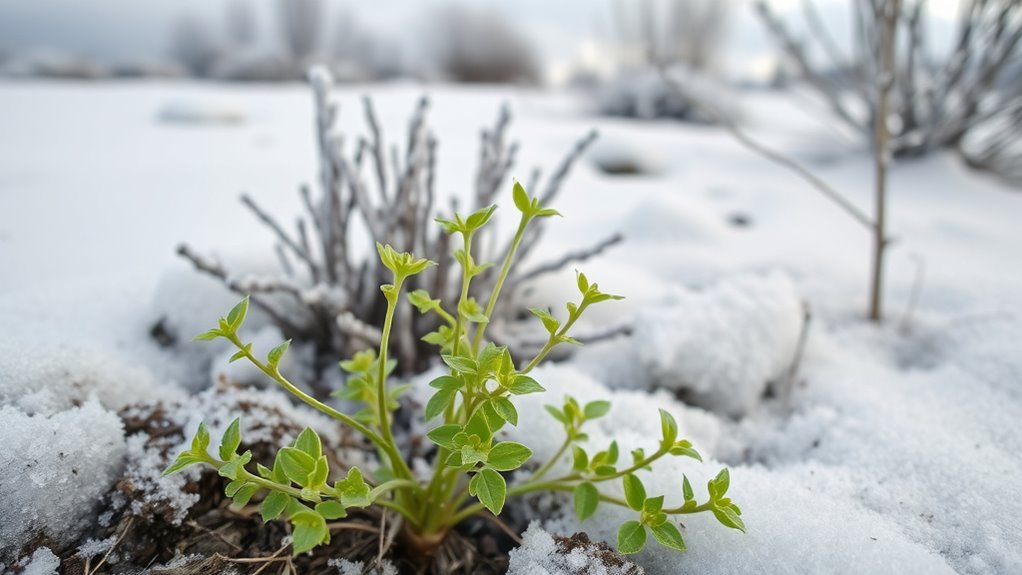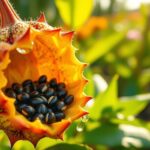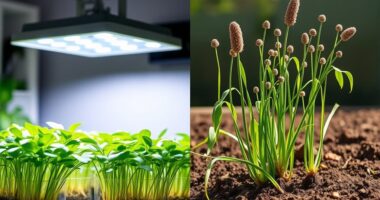Yes, you can grow chia in cold climates by choosing frost-tolerant varieties suited for shorter seasons, starting your seeds indoors early, and transplanting them outdoors after frost risk passes. Improve your soil with organic matter, use mulching to insulate roots, and select sunny microclimates or sheltered spots. Protect your plants with frost covers during cold snaps. Implementing these tips increases your chances of success—continue exploring for more detailed strategies to grow chia in cooler regions.
Key Takeaways
- Choose cold-hardy chia varieties labeled as frost-tolerant or suitable for short growing seasons.
- Start planting early indoors or in greenhouses, then transplant after frost risk passes.
- Use well-draining soil, add organic matter, and mulch to protect roots and improve soil warmth.
- Select microclimates like south-facing slopes or sheltered areas to maximize sunlight exposure.
- Employ frost protection methods such as row covers and blankets during cold spells to enhance survival.

Growing chia in cold climates might seem challenging, but with the right techniques, it’s definitely possible. The key factors to consider are winter hardiness and frost tolerance, which determine whether chia can survive and thrive through colder seasons. While chia is traditionally grown in warmer regions, understanding how to improve its resilience in cooler conditions can open up new possibilities for gardeners in cooler regions.
First, selecting cold-hardy chia varieties is essential. Some strains have better winter hardiness and frost tolerance, making them more suitable for areas with lower temperatures. Look for seed varieties labeled as frost-tolerant or suitable for short growing seasons. These types are more likely to withstand early frosts and cooler soil temperatures, giving you a better shot at successful cultivation.
Choose frost-tolerant chia varieties for better winter hardiness and cooler climate success.
Next, timing your planting is vital. In cold climates, you want to start your chia early enough to maximize the growing season but not so early that seedlings are exposed to late frosts. Using season extension methods like indoor sowing or starting seeds in a greenhouse can give your plants a head start. Once seedlings are strong enough, transplant them outdoors after the danger of frost has passed, ensuring they’re established before colder weather sets in.
You should also pay attention to soil conditions. Chia prefers well-draining soil with a neutral pH, but in colder climates, adding organic matter can improve soil warmth and fertility. Mulching around your plants is an effective way to insulate the roots, increase soil temperature, and protect against sudden temperature drops. Mulch acts as a buffer, helping to maintain consistent soil conditions that support winter hardiness and frost tolerance.
Choosing the right planting location also matters. Find a spot with maximum sunlight exposure, ideally on a south-facing slope or near a wall that can absorb and radiate heat. Elevate your planting beds if possible, as higher elevations tend to be colder and more exposed to frost. Providing some wind protection can further reduce chilling effects and help your chia plants withstand cold snaps.
Finally, consider using row covers or frost blankets during unexpected cold spells. These coverings trap heat and create a microclimate around your plants, boosting frost tolerance and helping chia survive through chilly nights. Regular monitoring of weather forecasts allows you to take quick action if a hard frost is predicted, giving your plants extra protection. Additionally, selecting frost-tolerant varieties and employing microclimate strategies can significantly enhance your success in colder regions.
Frequently Asked Questions
How Long Does It Take for Chia to Mature in Cold Climates?
Chia typically takes about 9 to 15 weeks to mature, but in colder climates, your growing season may be shorter. You might need to start seeds indoors or use season extension techniques. Expect harvest timing to shift later, possibly by a few weeks. To guarantee successful growth, choose the right variety and protect your plants from frost. Patience and careful planning help you optimize your harvest even in cooler conditions.
Can Chia Seeds Survive Winter Frost When Grown Outdoors?
Think of chia seeds as resilient as hardy pioneers. When grown outdoors, you might wonder if they can survive winter frost. Chia frost resistance is limited; cold temperatures can damage seed viability and even kill young plants. To protect your crop, consider mulching or bringing plants indoors during frost. With proper care, you improve your chances of maintaining healthy chia plants despite chilly conditions.
What Are the Best Indoor Growing Conditions for Cold-Region Chia?
You should keep your indoor chia plant in a warm, well-lit spot with plenty of natural light or grow lights that mimic sunlight’s spectrum. Maintain indoor humidity around 50-70% to prevent the soil from drying out too quickly. Guarantee the temperature stays between 65-85°F, avoiding cold drafts. Proper light and humidity help your chia thrive indoors, even in cooler regions.
Are There Specific Chia Varieties Better Suited for Cooler Temperatures?
Think of chia varieties as explorers, each with unique strengths. Yes, some cold-tolerant varieties are better suited for cooler temperatures, thanks to regional adaptation. You should seek out these resilient types, which thrive in lower temperatures and are designed to handle chilly conditions. By choosing the right regional adaptation, you increase your chances of successful growth, turning your cooler region into a thriving chia garden.
How Can I Protect Chia Plants From Cold Snaps and Frost?
To safeguard your chia plants from cold snaps and frost, use mulching techniques like straw or compost to insulate the soil and keep roots warm. Additionally, select frost-resistant varieties that can withstand lower temperatures. Cover your plants with row covers or cloches during cold nights, and consider moving potted chia indoors if possible. These steps help ensure your plants survive and thrive despite chilly weather.
Conclusion
While cold climates might not be the ideal stage for chia to shine, with a little extra care and a touch of patience, you can still enjoy its benefits. Think of it as gently coaxing a shy bloom into full display—your efforts can help it flourish even in cooler settings. So, don’t be discouraged by the chill; with a bit of ingenuity, you’ll find ways to nurture your chia and savor its healthy rewards.














